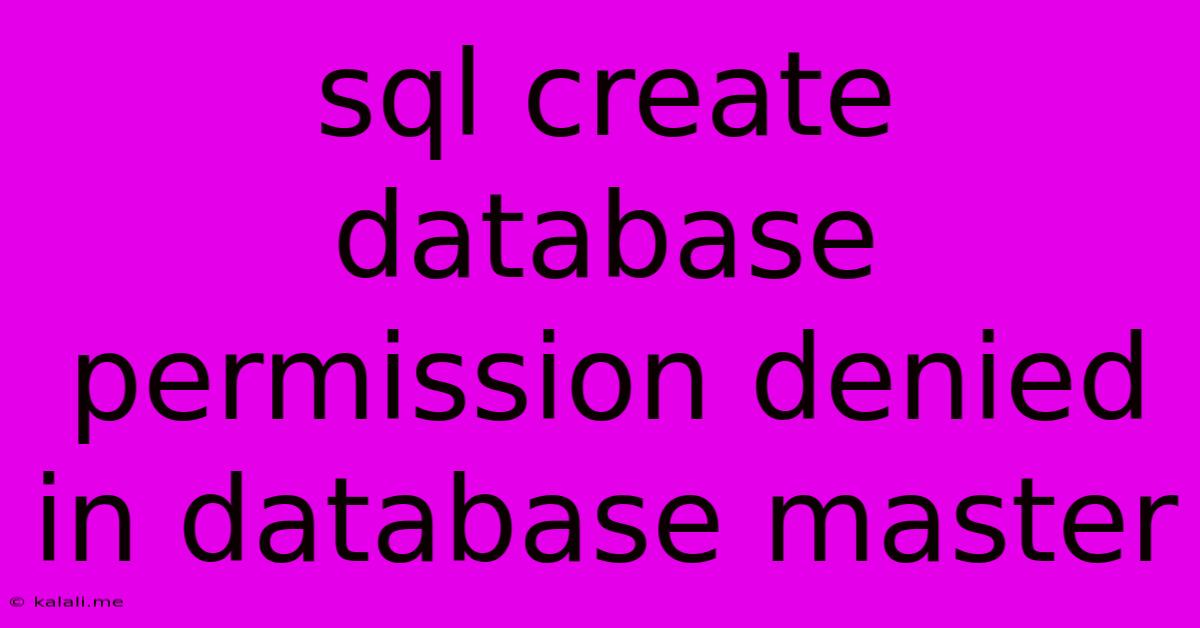Sql Create Database Permission Denied In Database Master
Kalali
May 30, 2025 · 3 min read

Table of Contents
SQL Server: Resolving "Create Database Permission Denied" in Master Database
Getting the dreaded "Create Database permission denied" error in SQL Server's master database is a common issue for database administrators and developers. This error message means your SQL Server user account lacks the necessary privileges to create new databases. This article will guide you through troubleshooting and resolving this permission issue, covering various scenarios and providing solutions for different user roles.
Understanding the Problem:
The master database is the core of your SQL Server instance. It holds system-level information and crucial metadata. Creating new databases requires specific permissions within the master database, and attempting to do so without these privileges will result in the "Create Database permission denied" error. This error often occurs when you're working with a user account that doesn't have the CREATE DATABASE permission or doesn't belong to a role that grants this permission.
Troubleshooting and Solutions:
Here's a breakdown of common causes and how to address them:
1. User Account Permissions:
-
Verify User Permissions: The most common cause is insufficient permissions for your SQL Server login. You must explicitly grant the
CREATE DATABASEpermission to the user or assign them to a role with this privilege. -
Using SQL Server Management Studio (SSMS): Connect to your SQL Server instance using SSMS with an account that has the necessary administrative privileges (e.g.,
sysadmin). Then, follow these steps:- Right-click on the user or login in question.
- Select "Properties."
- Navigate to the "Permissions" page.
- Check the box for "CREATE DATABASE."
- Click "OK" to save the changes.
-
Using T-SQL: If you prefer using T-SQL, execute the following command (replace
'your_user_name'with your actual user name):GRANT CREATE DATABASE TO 'your_user_name';
2. Role-Based Permissions:
-
Fixed Server Roles: SQL Server offers pre-defined roles that grant specific permissions. The
sysadminfixed server role has the broadest permissions, includingCREATE DATABASE. Adding a user to thesysadminrole will grant them full control. However, adding users tosysadminshould be done cautiously, as it provides extensive privileges. -
Using SSMS: Add the user to the
sysadminrole through the SSMS interface. (Right-click on the login -> Properties -> Server Roles). -
Using T-SQL: Use the following T-SQL command to add the user to the
sysadminrole:ALTER SERVER ROLE sysadmin ADD MEMBER 'your_user_name'; -
Custom Roles: Consider creating a custom database role with more granular permissions. This allows more control over user access, minimizing security risks associated with the
sysadminrole.
3. Incorrect Login or Password:
- Double-Check Credentials: Ensure you're using the correct login credentials when connecting to SQL Server. An incorrect password will prevent you from executing any commands, including creating a database.
4. Server Configuration:
- SQL Server Configuration Manager: While less common, there might be server-side restrictions preventing database creation. Review the SQL Server Configuration Manager to ensure that the necessary services are running correctly and that there are no unusual configurations blocking database creation.
Best Practices:
- Principle of Least Privilege: Grant only the necessary permissions to users. Avoid adding users to the
sysadminrole unless absolutely required for administrative tasks. - Regular Security Audits: Periodically review user permissions and roles to ensure they are still appropriate and to identify any potential security vulnerabilities.
- Robust Password Policies: Enforce strong password policies to protect your SQL Server instance from unauthorized access.
By following these troubleshooting steps and implementing best practices, you can effectively resolve the "Create Database permission denied" error and manage your SQL Server environment securely. Remember to always test your changes in a non-production environment before applying them to a production database.
Latest Posts
Latest Posts
-
One Punch Man Manga Online Free
May 31, 2025
-
Is There A Lag On Airpods Gaming Pc
May 31, 2025
-
What Is Circumcision In The Bible
May 31, 2025
-
How To Use My Laptop As A Monitor
May 31, 2025
-
What Is A 2 Way Mirror
May 31, 2025
Related Post
Thank you for visiting our website which covers about Sql Create Database Permission Denied In Database Master . We hope the information provided has been useful to you. Feel free to contact us if you have any questions or need further assistance. See you next time and don't miss to bookmark.